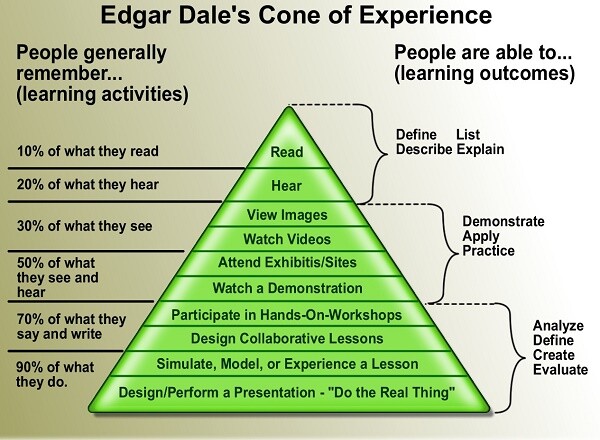How Much of a Book Do We Retain From Reading
Learning is infinitely circuitous. I contend that information technology is much more than complex than rocket scientific discipline. Human cognition is an amalgam of multiple systems and twisted interconnections. Even today's neuroscientists struggle to fully map our cognitive architecture.
As James D. Watson said: "The brain is the terminal and grandest biological borderland, the most complex thing we have even so discovered in our universe. It contains hundreds of billions of cells interlinked through trillions of connections. The brain boggles the mind."
Fortunately, wisdom has come down through the ages, from Aristotle to Pliny the Elderberry to Sophocles to Confucius, and then on. What's the percentage of information do we retain? This wisdom tin can be best summarized as that people call up:
- 10 percent of what they READ
- twenty percent of what they HEAR
- 30 percent of what they SEE
- 50 pct of what they SEE and HEAR
- 70 percentage of what they SAY and WRITE
- 90 percent of what they Do.
This is wisdom that we, as learning professionals, ought to integrate into our learning designs. Unfortunately, the complexities are daunting. I will attempt to disambiguate recommendations here, based on current understandings of brain science.
The Cone of Experience
First, information technology's helpful to review to Edgar Dale'southward elegant recommendations based on the visual metaphor of a cone. Dale, working in the 1940s, anticipated the findings of neuroscience decades before functional magnetic imaging techniques fabricated brain scientific discipline possible.

Annotation that articulate recommendations are evident in the cone. If we desire our learners to learn the nigh, long-term, nosotros should have them "design/perform a presentation." Or more than succinctly, they should "exercise the real thing." While this may seem confusing at commencement, its wisdom is undeniable.
Learning professionals should also help people "say and write" past having them "participate in hands-on-workshops." Again, if this seems confusing, ignore your skepticism and accept the wisdom, because neuroscientists are merely smarter than me and you lot. Finally, a note on audio visual content, it'southward much more valuable to "scout a demonstration" rather than "watch videos," especially if there are cute cats in those videos. Information technology seems that Edgar Dale even anticipated YouTube.
Indeed, many believe that Dale and his learning methods were simply amazing. Some have even said that he was the Buddha, reincarnated. Simply I digress…
The Zen of Learning
Did yous know that if someone mentions scientific verbiage, that yous're more than likely to believe them? Yes, in that location'due south even research on this!
Permit me tell you the truth: virtually everything I've written in this post up to this point is false! Erase it from your mind. Unfortunately, the data above is regularly conveyed within the learning field—as if information technology were immutable truth from the ancients or undeniable truth from the latest in neuroscience.
If y'all found yourself believing while reading the words to a higher place in this weblog post, you lot're not alone. Almost of us, it seems, are suckers for this kind of misinformation.
In a serial of manufactures in the most recent edition of the journal Educational Technology, I and three swain researchers explored how this misinformation has been passed down over time. You tin read my full synopsis of the research articles on my weblog, but permit me briefly outline the findings here:
There is no scientific evidence to support the percent-remembering numbers. Indeed, anybody who knows anything well-nigh research would know that results that round to numbers ending with a zero or a 5 are simply not credible. More chiefly, the numbers straight contradict much of what the real scientific research tells the states about learning.
People practise not necessarily think more than of what they hear than what they read. They exercise not necessarily call back more than of what they run across and hear than what they come across. The numbers are nonsense and the gild of say-so is wrong every bit well. Indeed, actual inquiry on human learning shows that homo beings are highly variable in how much they call back.
My collaborators—and I must say the others did well-nigh of the historical legwork—constitute the get-go mention of the percentage-remembering numbers from 1914 and 1922. In those publications the numbers were characterized as findings that were long known, but no specific inquiry was cited. It's actually a rather fascinating case study of how misinformation flows from person to person, from publication to publication. Indeed, we establish at least 8 publications commonly cited equally the place where the inquiry on the percentages could exist viewed in its elemental class. In NONE of these publications was any research described!

Edgar Dale did create a cone, but his didn't take any numbers on it. See an paradigm from the original version from his book.
Just as disquisitional, Dale didn't intend his cone, also called pyramid of learning, to be prescriptive. That is, he didn't want us to use his cone to make instructional-design decisions. He created his cone every bit a descriptive model, attempting to capture what the learning landscape was similar back in 1946.
What You Can Do
The most important thing nosotros can practise every bit professionals is to exist skeptical when we encounter "enquiry" or evidence. With a healthy dose of skepticism, nosotros're less likely to be infected with misinformation. In add-on, we need to stand up upward for the professionalism in our field by gently pushing back confronting the bad information—and those who convey it.
Cheque out The Debunker Society to make such a commitment.
Editor's Note: Source for the Dale Cone of Experience images is http://www.willatworklearning.com/myths_and_worse.
Cheque out similar articles: Brain Rules: What Science Says Nigh How We Larn
This article was originally published in March 2015 and has since been updated with new information and resources.
Source: https://www.td.org/insights/debunk-this-people-remember-10-percent-of-what-they-read
0 Response to "How Much of a Book Do We Retain From Reading"
Post a Comment